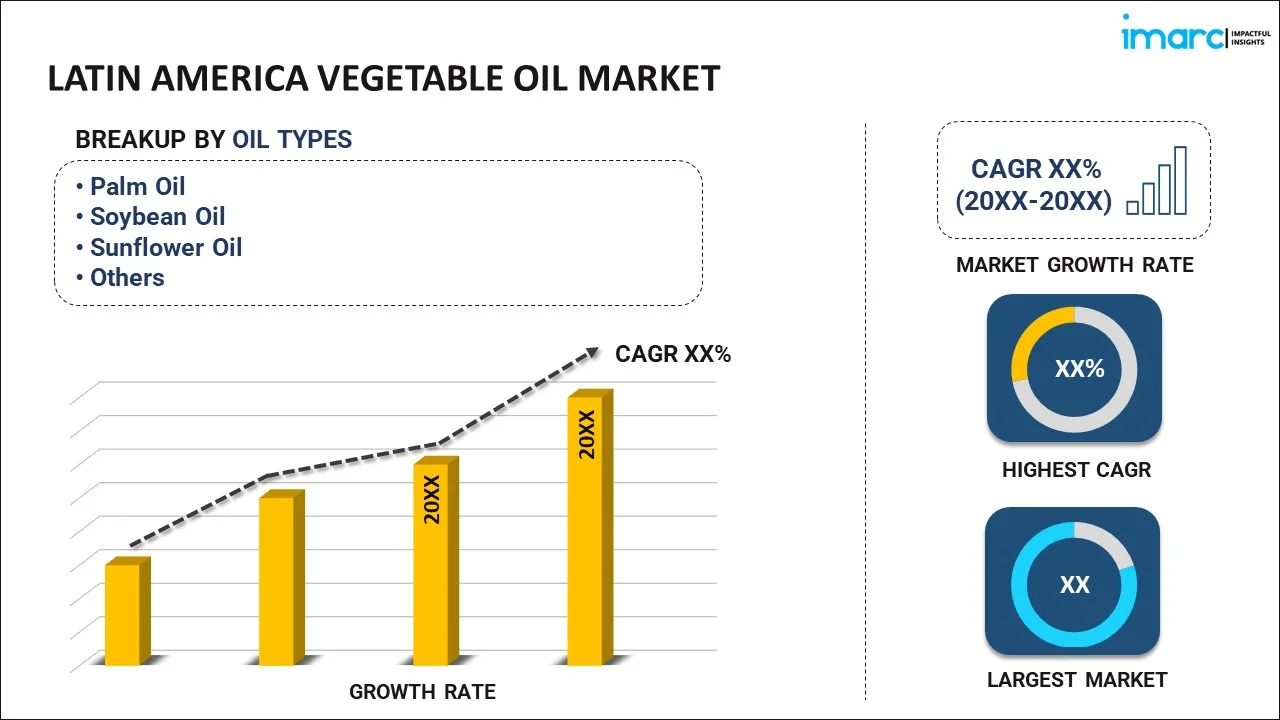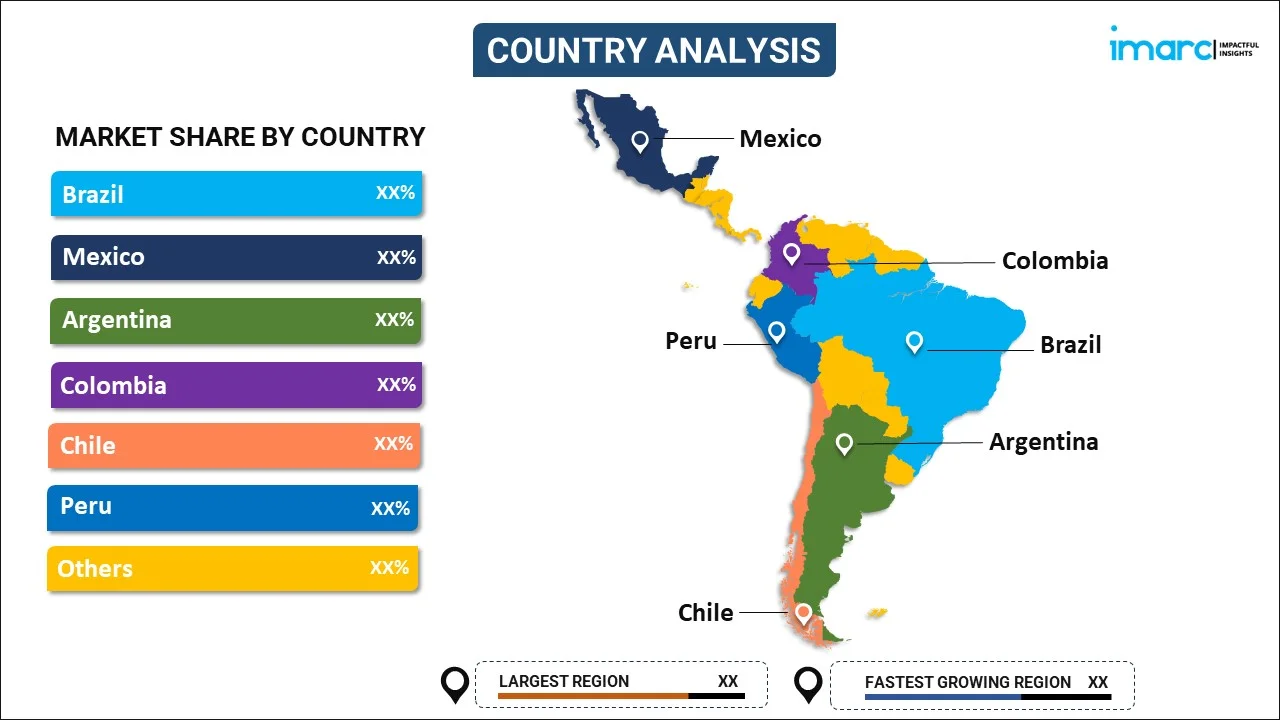
Latin America Vegetable Oil Market Report by Oil Type (Palm Oil, Soybean Oil, Sunflower Oil, Canola Oil, Coconut Oil, Palm Kernal, and Others), Application (Food Industry, Biofuels, and Others), and Country 2025-2033
Market Overview:
Latin America vegetable oil market size reached USD 17.7 Billion in 2024. Looking forward, IMARC Group expects the market to reach USD 24.1 Billion by 2033, exhibiting a growth rate (CAGR) of 3.20% during 2025-2033. The rising investments in R&D activities by companies to discover new industrial applications for this oil are primarily augmenting the regional market.
|
Report Attribute
|
Key Statistics
|
|---|---|
|
Base Year
|
2024 |
|
Forecast Years
|
2025-2033
|
|
Historical Years
|
2019-2024
|
| Market Size in 2024 | USD 17.7 Billion |
| Market Forecast in 2033 | USD 24.1 Billion |
| Market Growth Rate (2025-2033) | 3.20% |
Vegetable oil, a liquid fat derived from diverse plants, primarily seeds or fruits, finds common sources in soybean, corn, sunflower, and canola. Extensively applied in cooking and baking, it serves as a heat transfer medium, enhances flavor, and contributes moisture to food. Beyond culinary uses, vegetable oils play a role in the manufacturing of soaps, skincare items, and biofuels. Abundant in essential fatty acids, their nutritional composition varies based on the plant source. Certain vegetable oils are notably rich in unsaturated fats and beneficial for heart health when consumed moderately.
Latin America Vegetable Oil Market Trends:
The vegetable oil market in Latin America is currently experiencing a transformative phase, driven by a blend of drivers and trends that reflect the region's dynamic agricultural landscape and evolving consumer preferences. Firstly, the growing demand for healthier cooking alternatives is a significant driver for the vegetable oil market. With an increasing focus on wellness and nutrition, consumers in Latin America are seeking vegetable oils that offer heart-healthy unsaturated fats, prompting a shift away from traditional cooking fats. Moreover, the expanding food and beverage industry in the region is fueling the demand for vegetable oils as a key ingredient, thereby acting as another significant growth-inducing factor. Additionally, sustainable and eco-friendly practices are influencing trends in the Latin America vegetable oil market. Furthermore, government initiatives promoting biofuels and renewable energy sources are shaping the vegetable oil market in Latin America. Besides this, vegetable oils, being a key component in biofuel production, are gaining traction as an alternative energy source, aligning with the region's commitment to sustainable energy solutions. In conclusion, the latest drivers and trends in the Latin America vegetable oil market include the demand for healthier cooking options, the influence of the food and beverage industry, a focus on sustainability, and the integration of vegetable oils into the biofuel sector. These factors will collectively fuel the regional market over the forecasted period.
Latin America Vegetable Oil Market Segmentation:
IMARC Group provides an analysis of the key trends in each segment of the market, along with forecasts at the regional and country levels for 2025-2033. Our report has categorized the market based on oil type and application.
Oil Type Insights:

- Palm Oil
- Soybean Oil
- Sunflower Oil
- Canola Oil
- Coconut Oil
- Palm Kernel Oil
- Others
The report has provided a detailed breakup and analysis of the market based on the oil type. This includes palm oil, soybean oil, sunflower oil, canola oil, coconut oil, palm kernel oil, and others.
Application Insights:
- Food Industry
- Biofuels
- Others
A detailed breakup and analysis of the market based on the application have also been provided in the report. This includes food industry, biofuels, and others.
Country Insights:

- Brazil
- Mexico
- Argentina
- Colombia
- Chile
- Peru
- Others
The report has also provided a comprehensive analysis of all the major regional markets, which include Brazil, Mexico, Argentina, Colombia, Chile, Peru, and Others.
Competitive Landscape:
The market research report has also provided a comprehensive analysis of the competitive landscape. Competitive analysis such as market structure, key player positioning, top winning strategies, competitive dashboard, and company evaluation quadrant has been covered in the report. Also, detailed profiles of all major companies have been provided.
Latin America Vegetable Oil Market Report Coverage:
| Report Features | Details |
|---|---|
| Base Year of the Analysis | 2024 |
| Historical Period | 2019-2024 |
| Forecast Period | 2025-2033 |
| Units | Billion USD |
| Scope of the Report | Exploration of Historical and Forecast Trends, Industry Catalysts and Challenges, Segment-Wise Historical and Predictive Market Assessment:
|
| Oil Types Covered | Palm Oil, Soybean Oil, Sunflower Oil, Canola Oil, Coconut Oil, Palm Kernal, Others |
| Applications Covered | Food Industry, Biofuels, Others |
| Countries Covered | Brazil, Mexico, Argentina, Colombia, Chile, Peru, Others |
| Customization Scope | 10% Free Customization |
| Post-Sale Analyst Support | 10-12 Weeks |
| Delivery Format | PDF and Excel through Email (We can also provide the editable version of the report in PPT/Word format on special request) |
Key Questions Answered in This Report:
- How has the Latin America vegetable oil market performed so far and how will it perform in the coming years?
- What has been the impact of COVID-19 on the Latin America vegetable oil market?
- What is the breakup of the Latin America vegetable oil market on the basis of oil type?
- What is the breakup of the Latin America vegetable oil market on the basis of application?
- What are the various stages in the value chain of the Latin America vegetable oil market?
- What are the key driving factors and challenges in the Latin America vegetable oil?
- What is the structure of the Latin America vegetable oil market and who are the key players?
- What is the degree of competition in the Latin America vegetable oil market?
Key Benefits for Stakeholders:
- IMARC’s industry report offers a comprehensive quantitative analysis of various market segments, historical and current market trends, market forecasts, and dynamics of the Latin America vegetable oil market from 2019-2033.
- The research report provides the latest information on the market drivers, challenges, and opportunities in the Latin America vegetable oil market.
- Porter's five forces analysis assist stakeholders in assessing the impact of new entrants, competitive rivalry, supplier power, buyer power, and the threat of substitution. It helps stakeholders to analyze the level of competition within the Latin America vegetable oil industry and its attractiveness.
- Competitive landscape allows stakeholders to understand their competitive environment and provides an insight into the current positions of key players in the market.
Need more help?
- Speak to our experienced analysts for insights on the current market scenarios.
- Include additional segments and countries to customize the report as per your requirement.
- Gain an unparalleled competitive advantage in your domain by understanding how to utilize the report and positively impacting your operations and revenue.
- For further assistance, please connect with our analysts.
 Inquire Before Buying
Inquire Before Buying
 Speak to an Analyst
Speak to an Analyst
 Request Brochure
Request Brochure
 Request Customization
Request Customization




.webp)




.webp)












